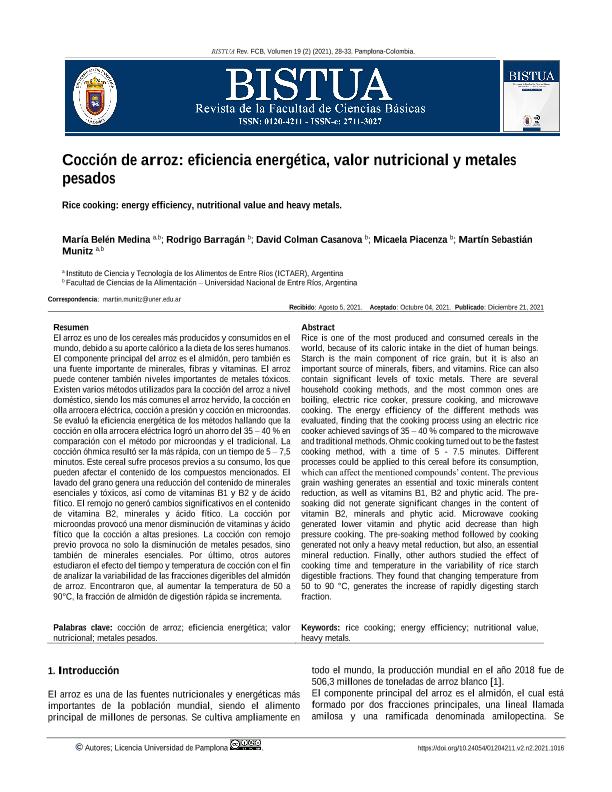Artículo
El arroz es uno de los cereales más producidos y consumidos en el mundo, debido a su aporte calórico a la dieta de los seres humanos. El componente principal del arroz es el almidón, pero también es una fuente importante de minerales, fibras y vitaminas. El arroz puede contener también niveles importantes de metales tóxicos. Existen varios métodos utilizados para la cocción del arroz a nivel doméstico, siendo los más comunes el arroz hervido, la cocción en olla arrocera eléctrica, cocción a presión y cocción en microondas. Se evaluó la eficiencia energética de los métodos hallando que la cocción en olla arrocera eléctrica logró un ahorro del 35 – 40 % en comparación con el método por microondas y el tradicional. La cocción óhmica resultó ser la más rápida, con un tiempo de 5 – 7,5 minutos. Este cereal sufre procesos previos a su consumo, los que pueden afectar el contenido de los compuestos mencionados. El lavado del grano genera una reducción del contenido de minerales esenciales y tóxicos, así como de vitaminas B1 y B2 y de ácido fítico. El remojo no generó cambios significativos en el contenido de vitamina B2, minerales y ácido fítico. La cocción por microondas provocó una menor disminución de vitaminas y ácido fítico que la cocción a altas presiones. La cocción con remojo previo provoca no solo la disminución de metales pesados, sino también de minerales esenciales. Por último, otros autores estudiaron el efecto del tiempo y temperatura de cocción con el fin de analizar la variabilidad de las fracciones digeribles del almidón de arroz. Encontraron que, al aumentar la temperatura de 50 a 90°C, la fracción de almidón de digestión rápida se incrementa. Rice is one of the most produced and consumed cereals in the world, because of its caloric intake in the diet of human beings. Starch is the main component of rice grain, but it is also an important source of minerals, fibers, and vitamins. Rice can also contain significant levels of toxic metals. There are several household cooking methods, and the most common ones are boiling, electric rice cooker, pressure cooking, and microwave cooking. The energy efficiency of the different methods was evaluated, finding that the cooking process using an electric rice cooker achieved savings of 35 – 40 % compared to the microwave and traditional methods. Ohmic cooking turned out to be the fastest cooking method, with a time of 5 - 7.5 minutes. Different processes could be applied to this cereal before its consumption, which can affect the mentioned compounds’ content. The previous grain washing generates an essential and toxic minerals content reduction, as well as vitamins B1, B2 and phytic acid. The presoaking did not generate significant changes in the content of vitamin B2, minerals and phytic acid. Microwave cooking generated lower vitamin and phytic acid decrease than high pressure cooking. The pre-soaking method followed by cooking generated not only a heavy metal reduction, but also, an essential mineral reduction. Finally, other authors studied the effect of cooking time and temperature in the variability of rice starch digestible fractions. They found that changing temperature from 50 to 90 °C, generates the increase of rapidly digesting starch fraction.
Cocción de arroz: eficiencia energética, valor nutricional y metales pesados
Título:
Rice cooking: energy efficiency, nutritional value and heavy metals
Medina, María Belén ; Barragán, Rodrigo; Colman Casanova, David; Piacenza, Micaela; Munitz, Martín Sebastián
; Barragán, Rodrigo; Colman Casanova, David; Piacenza, Micaela; Munitz, Martín Sebastián
 ; Barragán, Rodrigo; Colman Casanova, David; Piacenza, Micaela; Munitz, Martín Sebastián
; Barragán, Rodrigo; Colman Casanova, David; Piacenza, Micaela; Munitz, Martín Sebastián
Fecha de publicación:
12/2021
Editorial:
Universidad de Pamplona. Facultad de Ciencias Básicas
Revista:
Bistua
ISSN:
0120-4211
e-ISSN:
2711-3027
Idioma:
Español
Tipo de recurso:
Artículo publicado
Clasificación temática:
Resumen
Palabras clave:
COCCION DE ARROZ
,
EFICIENCIA ENERGETICA
,
VALOR NUTRICIONAL
,
METALES PESADOS
Archivos asociados
Licencia
Identificadores
Colecciones
Articulos (ICTAER)
Articulos de INSTITUTO DE CIENCIA Y TECNOLOGIA DE LOS ALIMENTOS DE ENTRE RIOS
Articulos de INSTITUTO DE CIENCIA Y TECNOLOGIA DE LOS ALIMENTOS DE ENTRE RIOS
Citación
Medina, María Belén; Barragán, Rodrigo; Colman Casanova, David; Piacenza, Micaela; Munitz, Martín Sebastián; Cocción de arroz: eficiencia energética, valor nutricional y metales pesados; Universidad de Pamplona. Facultad de Ciencias Básicas; Bistua; 19; 2; 12-2021; 1-6
Compartir
Altmétricas



